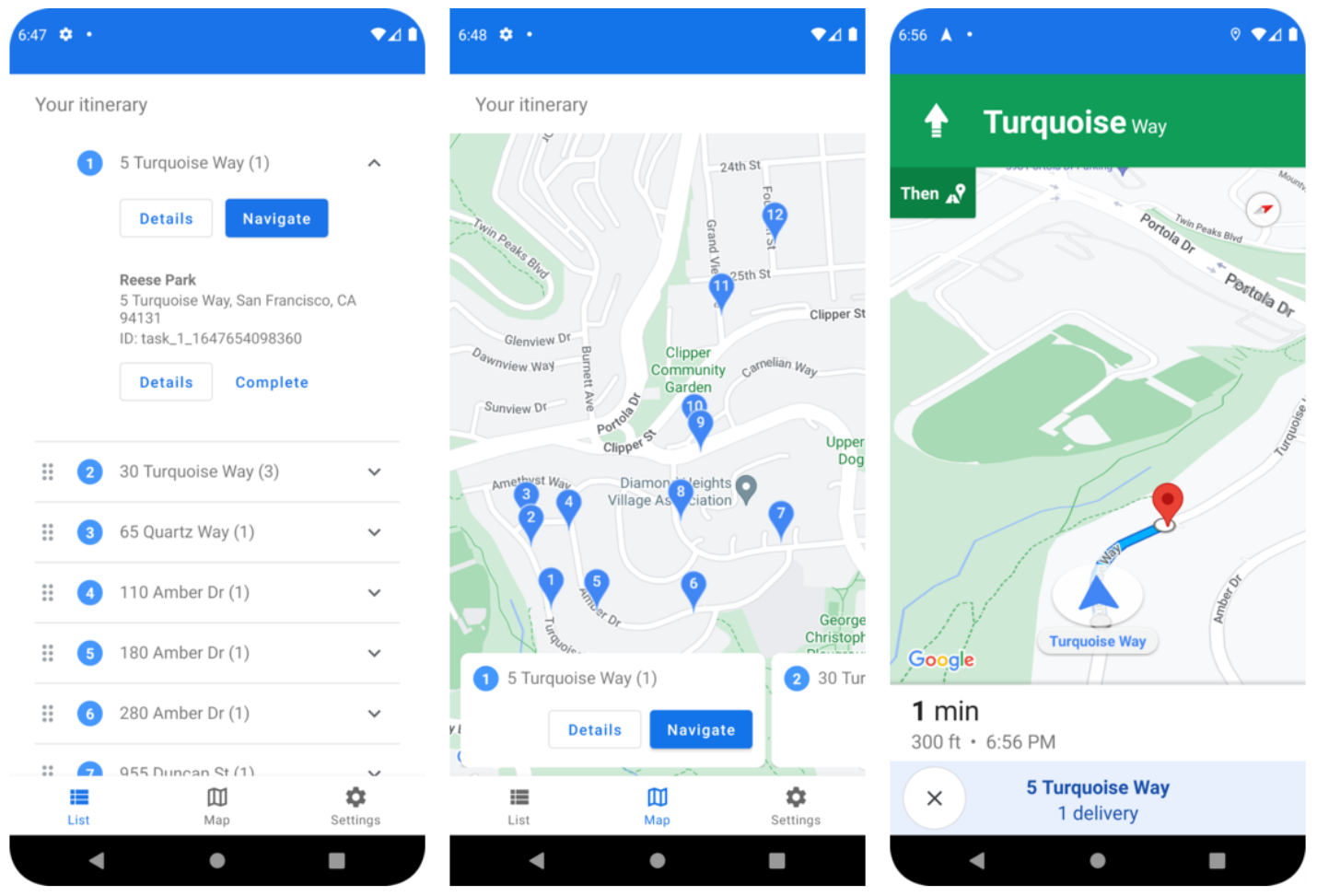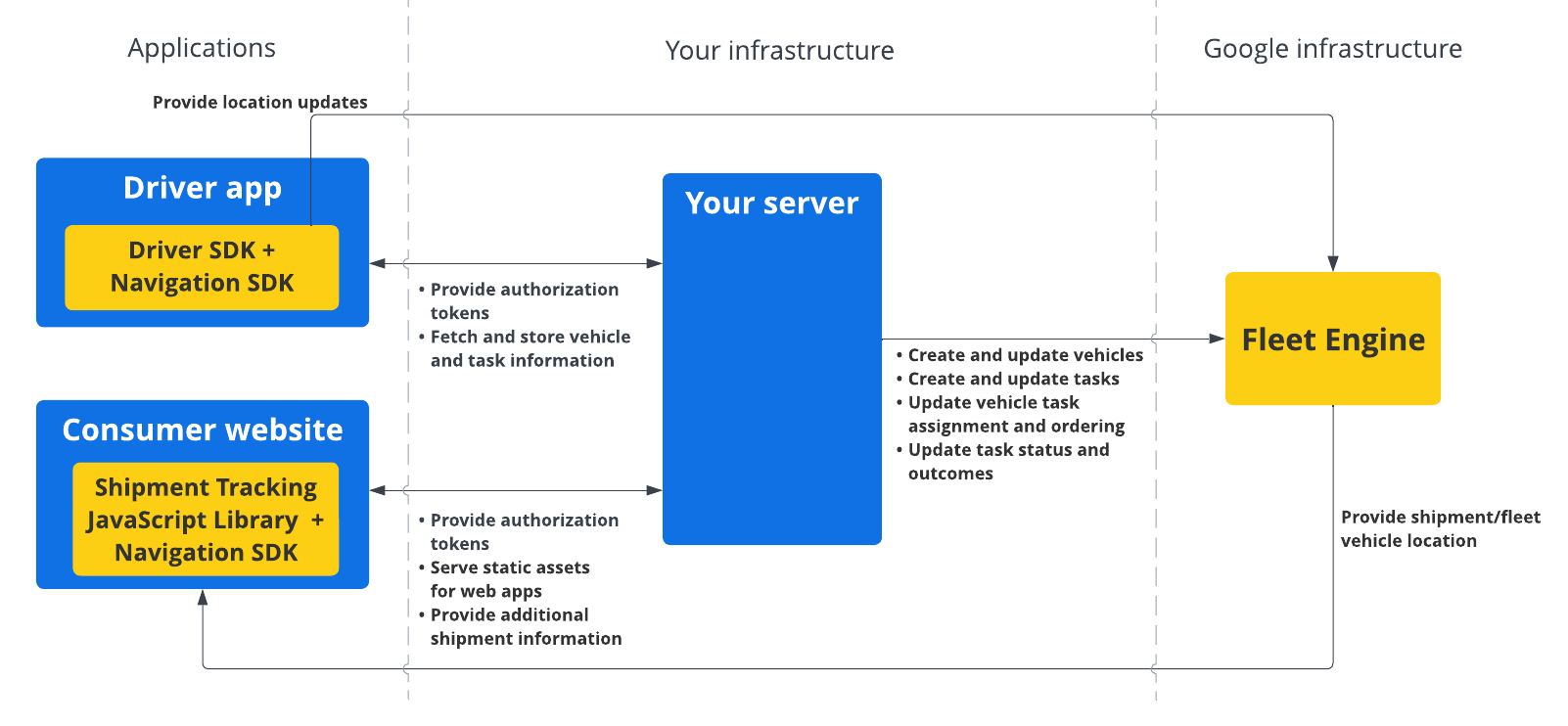
Driver SDK는 모바일 앱 툴킷이자 Fleet Engine의 기본 구성요소입니다. 이 SDK를 사용하면 운전자 앱에서 작업 할당을 관리하고 운전자 탐색 및 라우팅 기능을 사용 설정할 수 있습니다.
시작하기 전에
이 가이드에서는 다음 내용을 읽었다고 가정합니다.
예약된 작업용 Driver SDK란 무엇인가요?
Driver SDK는 차량 위치와 작업 업데이트를 Fleet Engine에 전달하여 Fleet Engine이 배송 차량과 할당된 배송 중지 및 작업을 관리할 수 있도록 합니다. 기본적으로 SDK는 이벤트 리스너를 사용하여 운전자가 운전을 시작할 때 위치 업데이트와 위도/경도 좌표를 현재 경로 세그먼트 및 Navigation SDK의 목적지와 함께 Fleet Engine에 전송합니다.
예약된 작업에 드라이버 SDK를 사용하는 이유는 무엇인가요?
Driver SDK를 사용하면 Fleet Engine과 더 쉽게 통합하여 운전자의 경로를 업데이트할 수 있습니다. 이 SDK를 사용하면 운전자는 할당을 관리하고 Google 지도 소비자 버전을 사용하는 것처럼 탐색할 수 있지만 다른 앱으로 전환할 필요는 없습니다.
예약된 작업에 Driver SDK로 할 수 있는 작업
예약된 작업에 드라이버 SDK를 사용하여 Fleet Engine과 다음을 통신합니다.
- 지도에 표시된 배송 차량의 실시간 위치입니다.
- 정류장의 위도/경도 좌표입니다.
- 정류장까지 남은 거리입니다.
- 정류장 도착 예정 시간입니다.
- Navigation SDK에서 제공하는 차량이 이동해야 하는 경로입니다.
예약된 작업용 Driver SDK의 작동 방식
Driver SDK는 라우팅 정보와 목적지를 위해 Navigation SDK에 종속됩니다. Navigation SDK의 정보와 함께 Driver SDK는 운전자 앱과 통합되어 Fleet Engine에 위치 업데이트, 위도/경도 좌표, 남은 거리, ETA 스트림을 제공합니다. 다른 모든 차량 데이터 업데이트는 데이터를 Fleet Engine에 중계하는 고객 백엔드로 전송해야 합니다.

예약된 작업에 Driver SDK를 사용하는 방법
플랫폼을 선택하여 Driver SDK 사용을 시작하는 방법을 확인하세요.
Android
| 1 | Android용 Driver SDK 가져오기 | 자세한 내용은 Driver SDK 가져오기를 참고하세요. |
| 2 | Google Cloud 콘솔 프로젝트 구성 | 자세한 내용은 Google Cloud 콘솔 프로젝트 구성을 참고하세요. |
| 3 | 종속 항목 선언 | 자세한 내용은 종속 항목 선언을 참고하세요. |
| 4 | 인증 토큰 만들기 | 자세한 내용은 인증 토큰 만들기를 참고하세요. |
| 5 | Driver SDK 초기화 | 자세한 내용은 Driver SDK 초기화를 참고하세요. |
| 6 | 차량 준비하기 | 자세한 내용은 차량 준비하기를 참고하세요. |
iOS
| 1 | iOS용 Driver SDK 다운로드 | 자세한 내용은 Driver SDK 가져오기를 참고하세요. |
| 2 | Google Cloud 콘솔 프로젝트 구성 | 자세한 내용은 Google Cloud 콘솔 프로젝트 구성을 참고하세요. |
| 3 | 인증 토큰 만들기 | 자세한 내용은 인증 토큰 만들기를 참고하세요. |
| 4 | Driver SDK 초기화 | 자세한 내용은 Driver SDK 초기화를 참고하세요. |
| 5 | 차량 준비하기 | 자세한 내용은 차량 준비하기를 참고하세요. |
다음 단계
Driver SDK를 설정하려는 플랫폼의 문서를 참고하세요.

